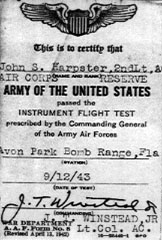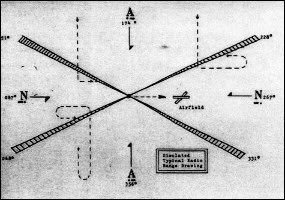![]()
Remembrances
of the B-Dash-Crash & My
Experiences with the 320th
by
John (Jack) S. Harpster, 442nd Bomb Squadron
|
|||||
|
|
Anyhow, back to RTU and B-26 training. Another “Shame on you” tale I can now tell is that of my first Instrument Check in a combat aircraft. Being a fighter pilot had always been my dream, so some of the less exciting parts of bomber crew training, like practicing instrument flight, was a bore to me in those days. The B-26 had a cloth hood used in instrument training for the pilot that was rather hard to install. After take off and once safely airborne, you would fight with all the snaps, hooks, and fasteners in an effort to fit it all the way around the pilots position. With the curtain in place, the pilot was completely cut off from any outside visual contact and the copilot was the safety observer. On this day of my instrument check, we took off and shortly thereafter my instructor said, “OK, now put up the hood. I struggled and fought with the durn thing for an eternity and finally he said, “Harpster, - take me home! Obviously you have not been practicing instruments under the hood as you should have been. When you have learned how to install the xxx xxxx thing and have actually practiced with it, then we will have another try at your instrument check". We went home and landed and I had failed my first, last, and only instrument flight check that I ever failed. My problem was with the instrument hood rather than the "Gauges” of the B-26. Later on, I did pass the second chance he gave me as attested by the Instrument card shown above. |
||||
|
|||||||||||||||||||||||||
|
|
|
||||||||||||||||||||||||

Copyright(c) 2006 320th Reunion Association. All rights reserved.



















 The Only Instrument Flight Check I Ever Failed
The Only Instrument Flight Check I Ever Failed
 Link Trainers
Link Trainers

